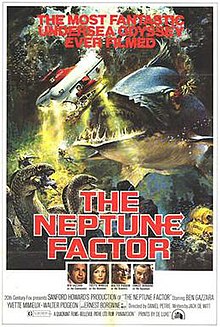
Sealab 2021 is an American adult animated television series created by Adam Reed and Matt Thompson for Cartoon Network's late-night programming block, Adult Swim. Cartoon Network aired the show's first three episodes in December 2000 before the official inception of the Adult Swim block on September 2, 2001, with the final episode airing on April 24, 2005. Sealab 2021 is one of the only four original Williams Street series that premiered in 2000 before Adult Swim officially launched, with the others being Aqua Teen Hunger Force, The Brak Show, and Harvey Birdman, Attorney at Law.

Diving activities are the things people do while diving underwater. People may dive for various reasons, both personal and professional. While a newly qualified recreational diver may dive purely for the experience of diving, most divers have some additional reason for being underwater. Recreational diving is purely for enjoyment and has several specialisations and technical disciplines to provide more scope for varied activities for which specialist training can be offered, such as cave diving, wreck diving, ice diving and deep diving. Several underwater sports are available for exercise and competition.

Yvette Carmen Mimieux was an American film and television actress who was a major star of the 1960s and 1970s. Her breakout role was in The Time Machine (1960). She was nominated for three Golden Globe Awards during her acting career.

The Aquarius Reef Base is an underwater habitat located 5.4 mi (8.7 km) off Key Largo in the Florida Keys National Marine Sanctuary, Florida, United States. It is the world's only undersea research laboratory and it is operated by Florida International University. It is deployed on the ocean floor 62 ft (19 m) below the surface and next to a deep coral reef named Conch Reef.
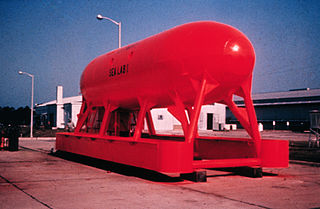
SEALAB I, II, and III were experimental underwater habitats developed and deployed by the United States Navy during the 1960s to prove the viability of saturation diving and humans living in isolation for extended periods of time. The knowledge gained from the SEALAB expeditions helped advance the science of deep sea diving and rescue, and contributed to the understanding of the psychological and physiological strains humans can endure.

Underwater habitats are underwater structures in which people can live for extended periods and carry out most of the basic human functions of a 24-hour day, such as working, resting, eating, attending to personal hygiene, and sleeping. In this context, 'habitat' is generally used in a narrow sense to mean the interior and immediate exterior of the structure and its fixtures, but not its surrounding marine environment. Most early underwater habitats lacked regenerative systems for air, water, food, electricity, and other resources. However, some underwater habitats allow for these resources to be delivered using pipes, or generated within the habitat, rather than manually delivered.

The Hall of Great Western Performers is a hall of fame at the National Cowboy & Western Heritage Museum in Oklahoma City, Oklahoma. It is a 4,000-square-foot (370 m2) presentation that explores how the American West has been interpreted in literature and film. Each year, the museum inducts performers to the hall in conjunction with the awarding of the Western Heritage Awards.

Scripps Canyon is a narrow submarine canyon in the Pacific Ocean, off the coast of Southern California, United States. The canyon is approximately 1 mile (1.6 km) long and joins La Jolla Canyon offshore.

Skyjacked is a 1972 American disaster film starring Charlton Heston and Yvette Mimieux. Directed by John Guillermin, the film is based on the David Harper novel Hijacked. James Brolin led an ensemble cast primarily playing the roles of passengers and crew aboard an airliner.
Ronald Josiah Taylor, was an Australian shark expert, as is his widow, Valerie Taylor. They were credited with being pioneers in several areas, including being the first people to film great white sharks without the protection of a cage. Their expertise has been called upon for films such as Jaws, Orca and Sky Pirates.

Confédération Mondiale des Activités Subaquatiques is an international federation that represents underwater activities in underwater sport and underwater sciences, and oversees an international system of recreational snorkel and scuba diver training and recognition. Its foundation in Monaco during January 1959 makes it one of the world's oldest underwater diving organisations.
Joseph Beverly MacInnis is a Canadian physician, author, and diver. In 1974, MacInnis was the first scientist to dive in the near-freezing waters beneath the North Pole. In 1976 he became a member of the Order of Canada.
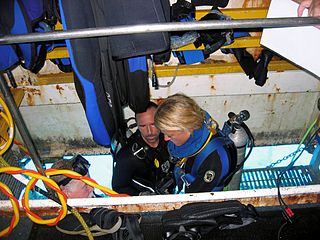
Craig B. Cooper is a professional aquanaut from the United States who served from 1991 to 2010 as Operations Manager for the Aquarius Reef Base underwater habitat. Cooper is known to fellow divers by the nickname "Coop".
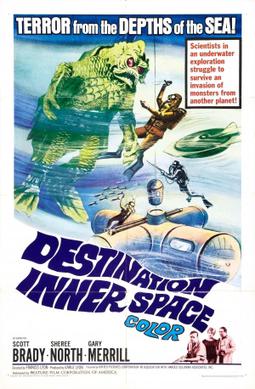
Destination Inner Space is a 1966 science fiction film produced by Earl Lyon, directed by Francis D. Lyon, written by Arthur C. Pierce, and stars Scott Brady, Gary Merrill, and Sheree North. The film was released to theaters in the US in May 1966 on a double bill with Frozen Alive (1964); its broadcasting rights were pre-sold to television so that some of the licensing fee could be used to finance the film's production. The story centers on scientists working in a laboratory on the floor of the ocean. They encounter an undersea flying saucer, after which the lab is attacked by a colorful aquatic humanoid monster who they fear may be the first in an alien invasion.
Lamar Boren was an underwater photography cinematographer renown for his work on films and television series for Ivan Tors and for underwater cinematography on several James Bond films.

John Morgan Wells was a marine biologist, and physiologist involved in the development of decompression systems for deep diving, and the use of nitrox as a breathing gas for diving. He is known for developing the widely used NOAA Nitrox I and II mixtures and their decompression tables in the late 1970s, the deep diving mixture of oxygen, helium, and nitrogen known as NOAA Trimix I, for research in undersea habitats, where divers live and work under pressure for extended periods, and for training diving physicians and medical technicians in hyperbaric medicine.
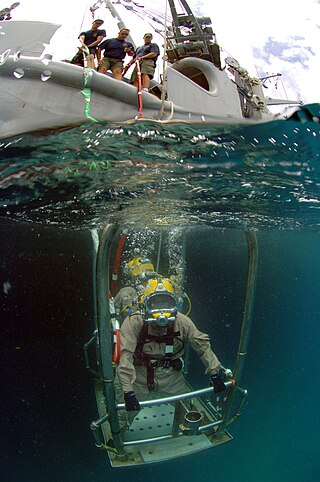
The following outline is provided as an overview of and topical guide to underwater diving:

The following index is provided as an overview of and topical guide to underwater divers:

This is a list of underwater divers whose exploits have made them notable. Underwater divers are people who take part in underwater diving activities – Underwater diving is practiced as part of an occupation, or for recreation, where the practitioner submerges below the surface of the water or other liquid for a period which may range between seconds to order of a day at a time, either exposed to the ambient pressure or isolated by a pressure resistant suit, to interact with the underwater environment for pleasure, competitive sport, or as a means to reach a work site for profit or in the pursuit of knowledge, and may use no equipment at all, or a wide range of equipment which may include breathing apparatus, environmental protective clothing, aids to vision, communication, propulsion, maneuverability, buoyancy and safety equipment, and tools for the task at hand.

Valerie May Taylor AM is an Australian conservationist, photographer, and filmmaker, and an inaugural member of the diving hall of fame. With her husband Ron Taylor, she made documentaries about sharks, and filmed sequences for films including Jaws (1975).
